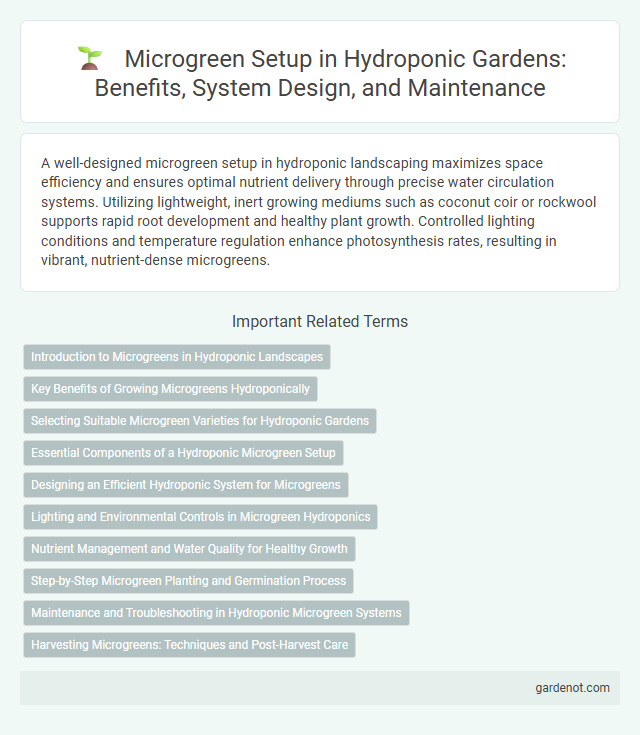A well-designed microgreen setup in hydroponic landscaping maximizes space efficiency and ensures optimal nutrient delivery through precise water circulation systems. Utilizing lightweight, inert growing mediums such as coconut coir or rockwool supports rapid root development and healthy plant growth. Controlled lighting conditions and temperature regulation enhance photosynthesis rates, resulting in vibrant, nutrient-dense microgreens.
Introduction to Microgreens in Hydroponic Landscapes
Microgreens are young, edible seedlings harvested shortly after germination, offering intense flavors and high nutrient density. In hydroponic landscapes, these small plants thrive without soil, utilizing nutrient-rich water solutions in controlled environments to optimize growth and yield. This setup enhances space efficiency and reduces water usage while producing fresh, vibrant microgreens year-round.
Key Benefits of Growing Microgreens Hydroponically
Growing microgreens hydroponically maximizes nutrient density and yield by providing precise control over water, nutrients, and environmental conditions. This method reduces water usage by up to 90% compared to traditional soil growing, while eliminating soil-borne diseases and pests. Hydroponic microgreen systems enable faster growth cycles and year-round production, making them ideal for sustainable urban agriculture and commercial farming.
Selecting Suitable Microgreen Varieties for Hydroponic Gardens
Selecting suitable microgreen varieties for hydroponic gardens involves considering fast-growing, nutrient-dense options like sunflower, radish, and pea shoots, which thrive in controlled environments. Varieties with high germination rates and disease resistance ensure consistent yields and minimize crop losses in hydroponic systems. Tailoring microgreen selection to local market demand and hydroponic setup conditions optimizes growth efficiency and profitability.
Essential Components of a Hydroponic Microgreen Setup
A hydroponic microgreen setup requires key components including a growing tray with proper drainage, a high-quality growing medium such as coconut coir or hemp mats, and nutrient-rich water solutions tailored for microgreens. Consistent LED grow lights providing the full spectrum spectrum optimize photosynthesis and accelerate growth cycles. Climate control elements like humidity regulators and temperature monitors ensure ideal conditions for seed germination and robust microgreen development.
Designing an Efficient Hydroponic System for Microgreens
Designing an efficient hydroponic system for microgreens involves optimizing space, light, and nutrient delivery to maximize growth and yield. Using flood and drain systems or nutrient film techniques enhances water and nutrient absorption while minimizing waste. Incorporating LED grow lights tailored to the specific light spectrum required by microgreens accelerates photosynthesis and ensures uniform growth.
Lighting and Environmental Controls in Microgreen Hydroponics
Optimal lighting for microgreen hydroponics relies on full-spectrum LED grow lights delivering 200-400 umol/m2/s photosynthetic photon flux density to promote rapid and uniform growth. Environmental controls must maintain temperature between 18-24degC and relative humidity at 50-70% to prevent fungal issues and enhance nutrient uptake. Automated timers and sensors ensure consistent light cycles of 12-16 hours daily, optimizing photosynthesis and maximizing yield in microgreen production.
Nutrient Management and Water Quality for Healthy Growth
Efficient nutrient management in hydroponic microgreen setups involves balancing essential macro- and micronutrients like nitrogen, phosphorus, potassium, calcium, and magnesium to promote robust growth and maximize yield. Maintaining optimal water quality with a pH range of 5.5 to 6.5 and electrical conductivity (EC) levels between 1.0 and 1.5 mS/cm ensures nutrient availability and prevents toxicity or deficiencies. Regular monitoring and adjustment of nutrient solutions and water parameters prevent algal growth and root diseases, enhancing overall microgreen health and productivity.
Step-by-Step Microgreen Planting and Germination Process
Begin the microgreen setup by selecting high-quality seeds like sunflower, radish, or pea, placing them evenly on a moist growing medium such as coconut coir or hemp mats. Maintain optimal conditions with a temperature range of 65-75degF, indirect light exposure, and consistent moisture by misting daily to encourage seed germination within 2-4 days. Transfer the sprouted seeds to a hydroponic tray system with nutrient-rich water, ensuring proper airflow and humidity levels to promote robust microgreen growth for harvest in 7-14 days.
Maintenance and Troubleshooting in Hydroponic Microgreen Systems
Consistent monitoring of pH levels between 5.5 and 6.5 is crucial for optimal nutrient absorption in hydroponic microgreen systems, while maintaining temperature around 68-72degF supports healthy growth. Regular inspection for mold, algae, and pests helps prevent common issues, and prompt adjustment of nutrient solution concentration can address deficiencies or toxicity. Efficient water circulation and ensuring clean, sterilized equipment minimize root rot and system blockages, enhancing overall system reliability.
Harvesting Microgreens: Techniques and Post-Harvest Care
Harvesting microgreens requires precise timing, typically 7-21 days after germination, when the first true leaves appear to maximize nutrient density and flavor. Use sharp scissors or knives to cut just above the soil line, avoiding damage to delicate stems and ensuring clean cuts that reduce the risk of mold. Post-harvest care includes immediate cooling and high humidity storage between 32-40degF (0-4degC) to maintain freshness, texture, and extend shelf life in hydroponic microgreen production.
Microgreen setup Infographic

 gardenot.com
gardenot.com